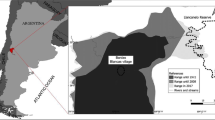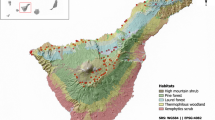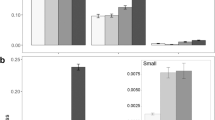Abstract
Herbivore and plant invasions can modify the structure and functioning of ecosystems through positive interactions that facilitate their mutual establishment. An important consequence of the feeding behaviour of rabbits is that they can play a key role in seed dispersal by endozoochory. We examined the diet and potential for dispersing Rosa rubiginosa and R. canina (Rosa spp.) of European rabbits introduced in a semiarid protected area of Argentina. We found entire seeds in 100% of the samples of Rosa spp. analysed (n = 11, 187 pellets). Our results indicate that the passage of Rosa spp. seeds through the digestive tract of rabbits (64%) did not diminish their viability in comparison to the seeds taken directly from fruits (66%) (χ2 = 0.09, p > 0.05). This study has identified new positive interactions between an invasive mammal and two invasive plants, a finding that suggests that these invader complexes could have a reciprocal effect on one another, which would potentially aid their invasive process in a semiarid protected area of Argentina.
Similar content being viewed by others
References
Blackburn TM, Essl E, Evans T, Hulme PE, Jeschke JM et al (2014) A unified classification of alien species based on the magnitude of their environmental impacts. PLoS Biol. https://doi.org/10.1371/journal.pbio.1001850
Bonino NA, Borrelli L (2006) Variación estacional de la dieta del conejo silvestre europeo (Oryctolagus cuniculus) en la región andina de Neuquén, Argentina. Ecología Austral 16:7–13
Braga RR, Gómez-Aparicio L, Heger T, Vitule JRS, Jeschke JM (2018) Structuring evidence for invasional meltdown: broad support but with biases and gaps. Biol Invasions 20:923–936
Castro S, Bozinovic F, Jaksic FM (2008) Ecological efficiency and legitimacy in seed dispersal of an endemic shrub (Lithrea caustica) by the European rabbit (Oryctolagus cuniculus) in central Chile. J. Arid Environ 72:1164–1173
Cuevas MF, Chillo V, Marchetta A, Ojeda RA (2011) Mammalia, Lagomorpha, Leporidae, Oryctolagus cuniculus Linnaeus, 1758: new record and its potential dispersal corridors for northern Mendoza, Argentina. Check List 7:565–566
Dacar MA, Giannoni SM (2001) A simple method for preparing reference slides of seed. J Range Manag 54:191–193
Dalmasso DD, Martinez Carretero E, Videla F, Puig S, Candia R (1999) Reserva natural Villavicencio (Mendoza, Argentina). Plan de manejo. Multequina 8:11–50
Dalmasso AD, Almirón M, Arroyo N (2011) Cerramientos vivos con especies nativas y exóticas rústicas. Experimentia 1:3–56
Gálvez-Bravo L, Belliure J, Rebollo S (2008) European rabbits as ecosystem engineers: warrens increase lizard density and diversity. Biodivers Conserv 18:869–885
Holechek J, Gross B (1982) Evaluation of different calculation procedures for microhistological analysis. J Range Manag 35:721–723
Howe FH, Smallwood J (1982) Ecology of seed dispersal. Annu Rev Ecol Evol Syst 13:201–228
Janzen DH (1980) When is it coevolution? Evolution 34:611–612
Manly BFJ, McDonald LL, Thomas DL (2002) Resource selection by animals. Statistical design and analysis for field studies, 2nd edn. Chapman & Hall, London
Mazzolari AC, Marrero HJ, Vázquez DP (2017) Potential contribution to the invasion process of different reproductive strategies of two invasive roses. Biol Invasions 19:615–623
Noy-Meir I (1973) Desert ecosystems: environment and producers. Annu Rev Ecol Evol Syst 4:25–51
Passera CB, Dalmasso AD, Borsetto O (1983) Método de Point Quadrat Modificado. Taller sobre arbustos forrajeros. FAO, IADIZA, Mendoza
Ryan JA, Ulrich JM, Thielen W, Teetor P, Bronder S (2019) Quantmod: Quantitative Financial Modelling Framework. R package version 0.4-13. https://CRAN.R-project.org/package=quantmod. Accessed 17 June 2019
Salas-Pascual S, Lugo SF, Cigala AN (2009) Interaction between two exotic invading species: endozoochory of Acacia farnesiana seeds by the European rabbit (Oryctolagus cuniculus). Open For Sci J 2:86–90
Schupp EW, Heaton HJ, Gomez JM (1997) Lagomorphs and the dispersal of seeds into communities dominated by exotic annual weeds. Great Basin Nat 57:253–258
Schupp EW, Jordano P, Gomez JM (2010) Seed dispersal effectiveness revisited: a conceptual review. New Phytol 188:333–353
Simberloff D, Von Holle B (1999) Positive interactions of nonindigenous species: invasional meltdown? Biol Invasions 1:21–32
Soriguer RC (1983) Consideraciones sobre el efecto de los conejos y los grandes herbívoros en los pastizales de la Vera de Doñana. Doñana Acta Vertebrata 10:155–163
Soriguer RC (1988) Alimentación del conejo (Oryctolagus cuniculus L. 1758) en Doñana. SO, España. Doñana Acta Vertebrata 15:141–150
Traveset A, Richardson DM (2006) Biological invasions as disruptors of plant reproductive mutualisms. Trends Ecol Evol 21:208–216
Zar JH (2010) Biostatistical analysis. Pearson Education, New Jersey
Acknowledgements
We thank Diego F. Vazquez for comments on this manuscript. Nelly Horak assisted in the English version. We are very grateful to the staff of Natural Reserve of Villavicencio and Recursos Naturales Renovables of Mendoza province. To the continuous support of our institution IADIZA-CONICET, CCT. This study was partially funded by ALARM (EU).
Author information
Authors and Affiliations
Corresponding author
Additional information
Publisher's Note
Springer Nature remains neutral with regard to jurisdictional claims in published maps and institutional affiliations.
Rights and permissions
About this article
Cite this article
Bobadilla, S.Y., Marchetta, A., Dacar, M.A. et al. Food habits of European rabbit and its role as seed dispersal of two Mosqueta roses: Facilitation among non-native species in a semiarid protected area of Argentina?. Biol Invasions 22, 1565–1571 (2020). https://doi.org/10.1007/s10530-020-02205-9
Received:
Accepted:
Published:
Issue Date:
DOI: https://doi.org/10.1007/s10530-020-02205-9







